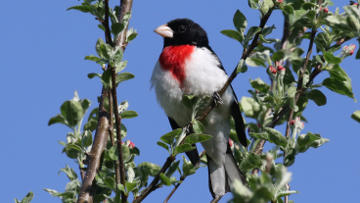

PHOTO COURTESY OF GARRY KESSLER
A male rose-breasted grosbeak
June 15, 2018, Page A6
NATURE NOTES
By Annie Reid
Westborough Community Land Trust
A birdfeeder beauty
Who wins the birdfeeder beauty contest? One likely candidate is a woodland bird that might appear at your birdfeeder if you happen to live next to woods – the male rose-breasted grosbeak.
A little smaller than a robin, rose-breasted grosbeaks (Pheucticus ludovicianus) are both beautiful and plain, depending on whether they’re male or female. The male is the one that’s beautiful, as is the case with many birds. A rosy red triangle on a white breast makes him easy to recognize at a glance. It also reminds you of his name. Otherwise, he’s mostly black on the head and back.
The female is the plain one, camouflaged for survival on the nest. She looks like a big sparrow with a brown back and head and lots of dark streaking on the breast. You might notice that she has a distinctive white “eyebrow” stripe. Young first-year birds look similar to females. You might see them in summer and fall.
Look also for something that the males, females, and young all share: the large beak – seen in our photo – that gives them the “grosbeak” (“big beak”) name. What good is it? This beak gives the birds many feeding options. They can eat many different foods, but especially seeds – which is why rose-breasted grosbeaks might show up at your birdfeeder for sunflower seeds and maybe even peanuts, especially in migration season. Like so many other birds, they are busy searching the foliage for caterpillars and other insects in the spring when they need protein for laying eggs and feeding growing chicks. In summer and fall they also feast on wild berries and fruits.
What else is noticeable about rose-breasted grosbeaks? It’s their song, which sounds somewhat like a robin’s but faster and more musical. We hear plenty of robins at this time of year, but if you hear a song that sounds like “a robin in a hurry” or “a robin that’s had voice training,” look around for a rose-breasted grosbeak. (In contrast, another beautiful woodland bird found in our area at this time of year, the scarlet tanager, sounds like “a robin with a cold.”) Both male and female rose-breasted grosbeaks sing, although the males usually sing more loudly. To hear the rose-breasted grosbeak song, go to:
https://www.allaboutbirds.org/guide/Rose-breasted_Grosbeak/sounds/
Rose-breasted grosbeaks nest in our area – maybe even in the woods near a birdfeeder. A pair builds a loose, flimsy nest in a fork of a tree or tall shrub. They share parental duties. Surprisingly for birds in which the male is eye-catching and the female is well camouflaged, the flashy male shares incubation duty. Even more surprisingly, male rose-breasted grosbeaks sing while sitting on the nest.
Whether you’re watching a birdfeeder or walking in the woods, keep your eyes and ears open for rose-breasted grosbeaks. You might be lucky enough to spot one. You don’t have to go deep into the woods to see them. Unlike various other woodland birds, they can be found in relatively small wooded areas and woodland edges. Many people go a lifetime without seeing these woodland beauties that regularly come to our area all the way from Mexico, Central America, or South America to breed.